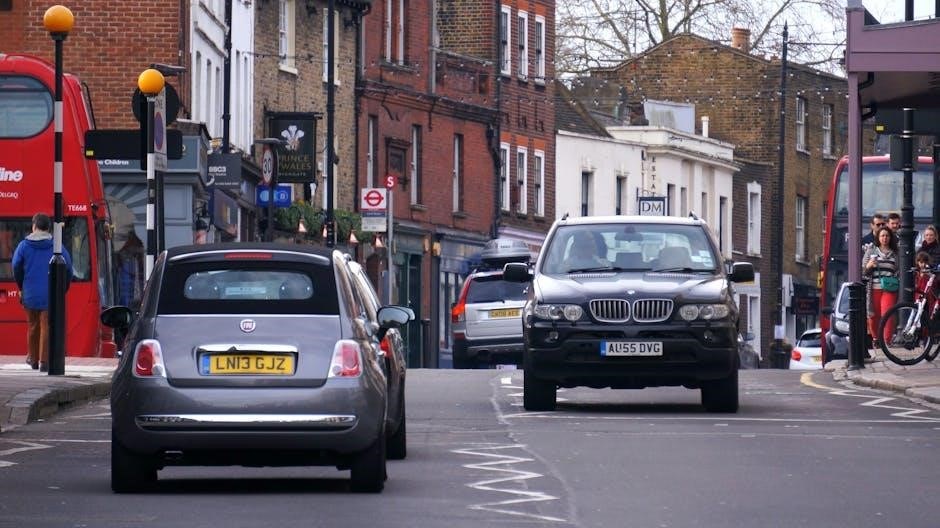Driving in Italy presents unique challenges, and a critical aspect is understanding Italian road signs. This knowledge is crucial for safe navigation and avoiding fines. Many signs are intuitive, but some local signs near historic towns can be confusing.
Importance of Understanding Italian Road Signs for Drivers
Understanding Italian road signs is paramount for drivers to ensure safety and compliance with local regulations. Many tourists struggle with the meaning of Italian road signs, leading to confusion and potential accidents. Familiarity with these signs helps drivers navigate effectively, especially in areas with unique signage like historic towns. Recognizing warning signs alerts drivers to potential hazards ahead, while understanding regulatory signs prevents traffic violations. A solid grasp of Italian road signs is essential for a smooth and stress-free driving experience in Italy, ultimately contributing to safer roads for everyone. Ignoring these signs can result in penalties.

Types of Italian Road Signs
Italian road signs are diverse, serving various purposes. They can be broadly categorized into warning, regulatory (prohibitory and mandatory), and information signs. Each type plays a crucial role in guiding drivers.
Warning Signs
Warning signs in Italy are designed to alert drivers to potential hazards ahead. These signs typically feature a red border and a white or yellow background, with a black symbol depicting the specific danger. Common warnings include sharp curves, intersections, pedestrian crossings, and the presence of animals. Be especially vigilant for signs indicating roundabouts, as Italians frequently use them. Recognizing these signs allows drivers to anticipate and safely react to changing road conditions, ultimately contributing to safer driving and avoiding accidents. Pay close attention to these signs, as they are designed to alert you of possible dangers ahead.
Regulatory Signs (Prohibitory and Mandatory)
Regulatory signs in Italy enforce traffic laws and ensure order on the roads. Prohibitory signs, often circular with a red border, indicate actions that are forbidden, such as no entry, no parking, or speed limits. Mandatory signs, usually circular and blue, instruct drivers on actions they must take, like direction of travel or minimum speed. Strict adherence to these regulatory signs is essential; ignoring them can result in fines and, more importantly, jeopardize safety. Familiarize yourself with these signs to navigate Italian roads legally and responsibly. Remember to always obey the speed limits and traffic laws.
Information Signs (including Tourist Information)
Information signs in Italy provide guidance and directions to various destinations. These signs are essential for navigating unfamiliar areas, especially for tourists. Tourist information signs, often brown, point towards historical sites, attractions, and cultural landmarks. Other information signs indicate city centers, airports, hotels, and stadiums. They typically feature black lettering on a white or blue background. These signs are incredibly helpful, assisting drivers in locating specific places and understanding distances. Pay attention to these signs to enhance your travel experience and avoid getting lost. Proper observation of the information signs is important for successful navigation.

Color Coding of Italian Road Signs
Italian road signs utilize color coding to quickly convey information. Green indicates highways (Autostrada), blue signifies non-toll roads, and white is used for urban areas and points of interest.
Green Signs (Highways/Autostrada)
Green signs in Italy denote the Autostrada, which are toll highways designed for efficient long-distance travel. These motorways generally have higher speed limits compared to other roads. Navigating using green signs will lead you along well-maintained routes, often connecting major cities and regions. Be prepared for toll payments along these routes. Green signs ensure a faster journey, but remember to factor in the cost of tolls. They are essential for planning efficient travel across Italy, especially when time is a constraint, and you want to reach your destination quickly.
Blue Signs (Non-Toll Roads)
Blue signs in Italy indicate non-toll roads, offering an alternative to the faster, but paid, Autostrada. These roads often wind through scenic countryside and smaller towns. Choosing blue-signed routes allows for a more leisurely journey. You will experience authentic Italian culture and discover hidden gems. While generally slower than the Autostrada, non-toll roads are free of charge. They provide a cost-effective way to explore Italy. Be mindful of potentially lower speed limits and varying road conditions. Blue signs are perfect for travelers who prioritize exploration and budget-friendly travel.
White Signs (Urban Areas and Points of Interest)
White road signs in Italy primarily guide drivers within urban areas and toward points of interest. These signs often feature black lettering and provide directions to local destinations like hotels, stadiums, and airports. They are essential for navigating the often-complex road networks of Italian cities. Keep an eye out for these signs when searching for specific landmarks or amenities. White signs can also indicate routes through residential areas. This will require vigilance regarding pedestrian traffic and lower speed limits. Their presence signifies a shift from highways to local roads.
Specific Road Signs to Pay Attention To
Certain Italian road signs require extra attention. Understanding ZTL (Zona Traffico Limitato) signs and parking regulations is crucial to avoid hefty fines. Pay close attention to speed limits indicated on signage.
ZTL (Zona Traffico Limitato) Signs
ZTL signs are critical for navigating Italian cities. These zones restrict traffic to residents and authorized vehicles during specific hours. Entering a ZTL without permission results in fines. Signs display permitted times and vehicle types. Cameras monitor entrances, automatically issuing tickets. Be aware of variations in ZTL rules between cities. Always check local regulations before entering a historic center. These zones aim to preserve historical areas and reduce congestion. Understanding ZTL signs is essential for avoiding unexpected costs during your Italian road trip and ensuring compliance with local laws.
Parking Signs (including payment information)
Italian parking signs can be complex, requiring careful attention to avoid fines. Signs use colors and symbols to indicate parking restrictions. Blue lines usually mean paid parking, requiring a ticket from a nearby machine. White lines indicate free parking, which may be time-limited. Yellow lines designate parking for residents or disabled individuals. Signs often specify days and hours when restrictions apply. Payment machines typically accept coins or cards. Display the ticket visibly on your dashboard. Be mindful of parking durations and return promptly to avoid penalties. Deciphering these signs correctly is essential for a stress-free experience;
Resources for Learning Italian Road Signs
Several resources exist to help drivers learn Italian road signs. Online guides and PDFs offer comprehensive information. Mobile apps also provide road sign recognition features for convenient learning.
Online Guides and PDFs
Many online resources are available to help drivers familiarize themselves with Italian road signs. Several websites offer comprehensive guides that explain the meaning of various signs, including warning, regulatory, and information signs. These guides often include clear images and descriptions to aid understanding.
PDF documents are also readily accessible, providing a downloadable and printable reference for studying road signs. These resources are particularly useful for those planning a road trip in Italy, allowing them to prepare in advance and enhance their driving experience while ensuring safety and compliance with traffic regulations.
Mobile Apps for Road Sign Recognition
For on-the-go assistance, several mobile applications are designed to help drivers recognize and understand Italian road signs. These apps often use image recognition technology, allowing users to simply point their smartphone camera at a sign to receive an instant translation and explanation.
Some apps also offer quizzes and interactive learning modules to reinforce knowledge of road signs. These mobile resources can be invaluable for navigating unfamiliar roads and ensuring drivers quickly grasp the meaning of signs they encounter. They are a convenient and effective tool for both preparation and real-time assistance while driving in Italy.

Navigating Roundabouts (Traffic Circles) in Italy
Roundabouts, or traffic circles, are a common feature on Italian roads. Entering a roundabout requires yielding to traffic already circulating within it. Drivers should enter when there is a safe gap in the traffic flow.
Once inside, maintain a consistent speed and be aware of other vehicles. Signal your intention to exit the roundabout clearly and in advance. Italian drivers generally navigate roundabouts efficiently, but it’s important to be attentive and decisive. Understanding the basic rules and observing local driving habits will help you navigate these intersections smoothly and safely, contributing to a more relaxed driving experience.

Penalties for Ignoring Road Signs
Ignoring road signs in Italy can lead to significant penalties. Fines vary depending on the infraction and can range from moderate to substantial amounts. For example, non-compliance with a “Do Not Enter” sign or speeding in a restricted zone can result in hefty fines.
Moreover, failing to adhere to traffic regulations indicated by road signs can also lead to points being deducted from your driver’s license. In severe cases, repeated violations may even result in the suspension or revocation of driving privileges. Therefore, it is crucial to pay close attention to all road signs and obey them diligently to avoid penalties and ensure road safety.